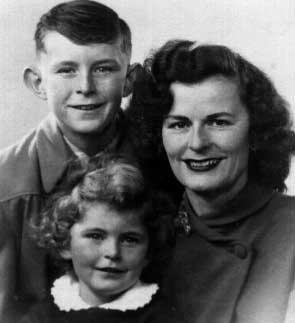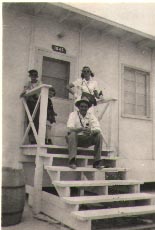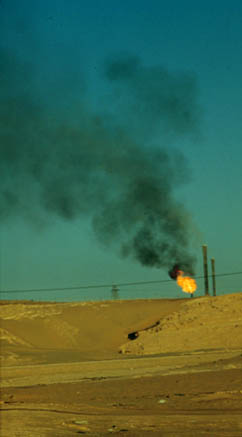|
|
|
|
|
|
|
|
|
|
|
|
|
|
|
|
|
|
|
 |
|
|
Dhahran Diary |
|
|
|
|
|
|
|
|
|
|
 |
|
|
|
|
Title: We Follow Dad to Dhahran
DD03 |
|
|
|
|
|
|
|
|
|
|
|
|
|
|
|
|
|
|
|
Our passport was dated December 27, 1948. JK was nearly four,
Rolf A. was 11, and Melitza was 34. |
|
|
|
|
|
|
My mother, sister, and I did not follow Dad until February of
1949 although we had several false alarms that made us think we
might get there by Christmas 1948. I think we were on a fairly
low priority as far as the company was concerned--the infamous
housing list. |
|
|
|
|
 |
Our first home was 1047. There were only two portables on Tenth
street, 1045 and 1047. There were no sidewalks and these portables
rested on concrete pylons without skirts to hide either their
underpinnings or pipes. We were at the edge of the desert on the
east side of Dhahran. The streets were oil and dirt mix. There
were few street lights. Most of the curbs were quite high and
the concrete was frequently in need of repair. Blasting and construction
assembly were the white noises of the community.
There were two main bus routes. One ran exclusively on King's
Road, the first street in Dhahran with a median. The other route
ran near the camp's perimeter. The central air conditioning plants
were a 24-hour-a-day source of noise. These plants preconditioned
the air; it was then sent through large pipes to secondary plants
in each home where the job was finished. The homes were very comfortable,
although the furnishings were institutional, lots of white metal,
wooden frame, and cushions.
The early camp was open to the desert on all sides. A perimeter
fence was erected in the early '50s. There were then two main
gates, one heading toward al Khobar, the beach, the hobby farm,
the golf course, and Dammam, and the other heading toward Abqaiq,
Half Moon Bay, and Ras Tanura. Along the west edge of Dhahran
was the shops area, the commissary, canteen, laundry, barbershop,
and post office. Beyond that was reclamation, a huge junk yard,
a place to gather everything from pipe to airplanes (photo). The
Western cemetery nestled into its edge as well. |
|
|
Portable 1047, our first home. Pictured with us is Mac MacFarlane, a bachelor
machinist from Dearborn, Michigan. He and Dad worked in the same
shop and were good friends. |
|
|
|
We had two kinds of water, raw and sweet. There were three faucets
in the kitchen sink; the sweet was for drinking and cooking. One
washed in raw water, which was quite high in solids. The camp
was well planted. Lawns were plugged and watered profusely. Privet
hedges abounded; these plants would go dormant if not watered.
All properties had fencing of either stone or barasti (palm frond);
oleander bushes, Acacia and almond trees, the occasional henna
tree, and periwinkle flowers were common plantings. Banyan trees
came later as did bougainvillea vines, and something we called
camel vine. Individuals experimented with various plantings.
There were odd pets in the early days. These included thuq (lizard),
gazelles, ravens, mynah birds, and even a koala bear. Before fences
were put up, the camp was wild with Saluki dogs, goats, donkeys,
and the occasional camel. There was fear of rabies so once the
perimeter fence was in place, the bigger exotic pets were usually
kept at the Hobby Farm.
The desert teemed with life. It was amazing. Dhahran was on a
fly way; African and other birds visited during the season. The
night sky in Arabia was spectacular. There were millions of stars
to see. Shooting stars were a regular occurrence. Later the rock
crushers tended to pollute the evening sky, depending on the prevailing
wind.
The night we arrived in Dhahran, the most impressive memory I
have is the smells of that Middle East culture. In our camp and
our neighboring center called Saudi Camp, the mixture of petroleum
and cooking odors was remarkable. More than anything, Dhahran
was a place of noises and smells.
Dad met us at the airport; he had a red car with special tires
and ARAMCO markings. We drove up from the airfield and parked
in front of a pile of sand. The last daylight had drained away.
There was barely a street and the porch light and naked stair
structure were a bit stark. We had neither yard, fence, nor walkway
to the front steps. We lugged our bags inside and checked out
the place. We were finally a family again.
The trip from Los Angeles had taken four days! JK and I were off
to bed after a can of Toddy, a chocolate drink that had to double
for milk. I really missed my milk those first few years!
It would be three or four months before our household goods arrived.
I think time zone differences awakened me around three A. M. I could
hear Mom and Dad talking quietly in the living room. The coffee
cups and spoons clinked; I suppose Mom couldn't’t sleep either
and Dad got up to keep her company. After a long separation, we
were finally back together. I was glad it was over. |
|
|
|
|
Dad didn’t have to work the next day. He showed us around camp,
recreation, the shops, the post office (Box 1383) and we even
drove higher up on the jebel where the stabilizer was situated.
We got to see one of the many flares close up. And so, our new
lifestyle began in Dhahran; it was February 14, 1949. |
|
|
|
|
|
|
|
|
|
|
 |
|
|
|
|
|
|
This photograph shows an oil byproduct, hydrogen sulfide gas, a deadly poisonous mixture to humans until disposed. The gas
is associated with the oil when lifted and is burned off by the
flares after separation.
In the early days, Dhahran's flares were one of the first landmarks
spotted in the distance. |
|
|
|
|
|
|
During the War, the Italians flew across the Arabian Peninsula to bomb the oil
fields at Dhahran. They arrived at night and targeted the flares
with little or no damage to the oil field. Dad told me someone
saw a worker carry a small, unexploded warhead into camp the next
morning. Everyone scattered in self defense. |
|
|
|
|
|
 |
|
|
|
|
Copyright ©1999-2006
Rolf A. Christophersen
All Rights Reserved.
Email
|
|
|
|
|
|